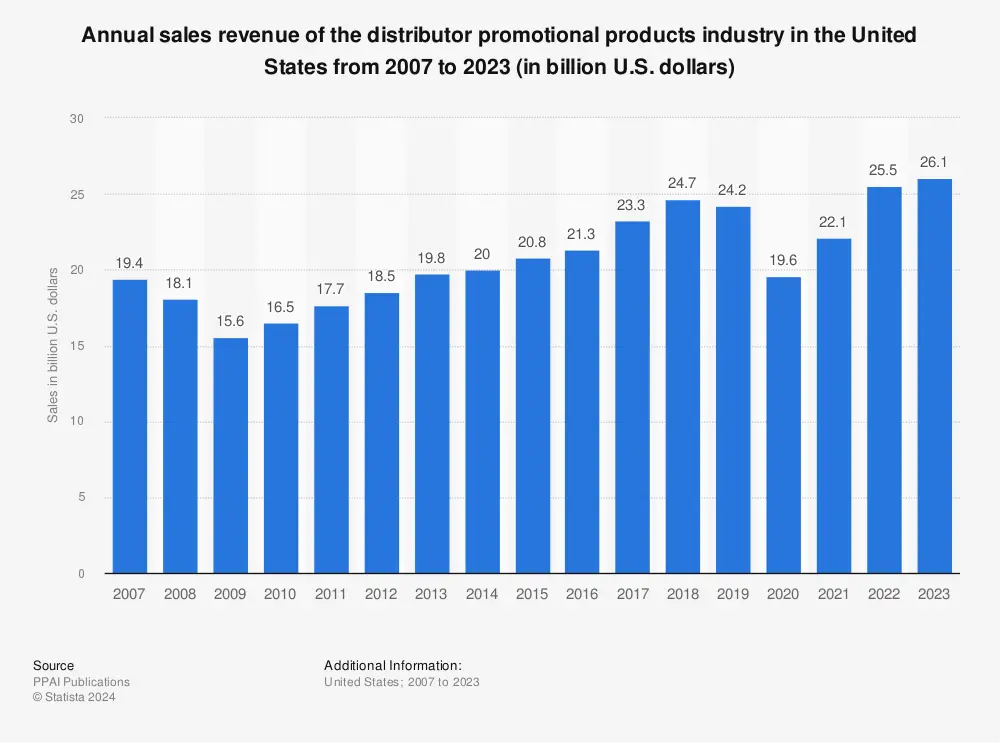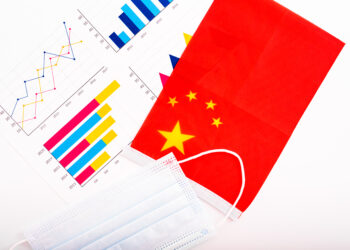Promotional swag, also known as promotional merchandise or promotional products, refers to branded items distributed at no cost to promote a company, brand, or event. These items are typically emblazoned with a company’s logo or slogan and are designed to increase brand awareness among consumers. The concept behind promotional swag is not just to advertise but to create a tangible connection between the brand and the recipient, fostering goodwill and brand recall. Swag ranges from everyday items like pens, mugs, and T-shirts to more innovative products like tech gadgets, eco-friendly containers, and personalized accessories, making them versatile tools in marketing arsenals.
Market Size of Promotional Swag

The promotional products industry is a significant part of the marketing sector, demonstrating steady growth over the years. As of my last update in April 2023, the global market for promotional products was valued at approximately $26.1 billion, with North America accounting for a substantial portion of this market. The United States, in particular, is one of the largest markets for promotional items, reflecting the country’s robust advertising culture and the widespread acceptance of swag as an effective marketing tool.
Top 5 Promotional Swag Items in the US
Custom T-Shirts: T-shirts are a perennial favorite for their visibility and variety. They serve as walking billboards for the brand, providing substantial exposure.
Branded Pens: Due to their utility and cost-effectiveness, pens are a go-to promotional item. They are easy to distribute and keep the brand in the consumer’s hand regularly.
Promotional Bags: Reusable tote bags, backpacks, and drawstring bags are popular for their practicality and environmental benefits. They offer excellent visibility in public spaces, doubling as eco-friendly statements.
Tech Accessories: Items like USB drives, power banks, and branded earbuds have gained popularity as promotional swag. They appeal to the tech-savvy consumer and provide value beyond mere branding.
Water Bottles and Mugs: Reusable drinkware is not only practical but also aligns with increasing environmental consciousness among consumers. Customized bottles and mugs are frequently used, ensuring regular brand exposure.
These items dominate the promotional swag market in the US due to their utility, appeal, and effectiveness in keeping the brand in the consumer’s everyday life, enhancing brand recognition and loyalty.
Should Your Business Spend on Frivolous Promotional Items? This question often sparks debate among small business owners. With budget constraints and the need for effective marketing, the choice between promotional items and traditional advertising is critical. This article dives deep into the effectiveness of both, aiming to guide small business owners in their marketing endeavors.
Let’s embark on a journey to unravel the intricacies of marketing strategies, from logo-laden pens to prime-time TV ads. By analyzing their return on investment, we offer insights to steer your business in the right direction.
Understanding Promotional Items
Definition and Examples
Promotional items, often dubbed ‘swag’, are products branded with a company’s logo or slogan, given away to promote a brand, corporate identity, or event. These range from logo apparel and custom pens to tech gadgets and eco-friendly totes. They’re tangible, often useful items meant to keep your brand in the public eye.
The Psychology Behind Promotional Items
The power of promotional items lies in their ability to connect on a personal level. They turn abstract brand concepts into tangible experiences. A well-chosen promotional item can make a brand feel more relatable, enhancing recall and loyalty. The psychology is simple: people love free things, but beyond that, they enjoy items that add value to their lives. This positive association transfers to your brand.
Pros and Cons
Pros:
- Cost-Effective: Often less expensive per impression compared to other advertising mediums.
- Longevity: They can provide continued exposure as people use or wear the item over time.
- Versatility: Wide range of items to fit various marketing strategies and audiences.
Cons:
- Saturation: The market is flooded with promotional items, making it hard to stand out.
- Relevance: Choosing items that don’t resonate with your target audience can be a waste.
- Measurement Difficulty: Tracking the direct impact on sales or brand awareness can be challenging.
Exploring Traditional Advertising
Definition and Examples
Traditional advertising encompasses media such as TV, radio, newspapers, and billboards. These methods are characterized by their broad reach and ability to build brand awareness quickly. They’re the megaphones of marketing, broadcasting your message far and wide.
The Impact on Brand Visibility
Traditional advertising shines in its capacity to reach a vast audience, including those outside a business’s immediate sphere. Its strength lies in frequency and familiarity, building trust through repeated exposure. This visibility can significantly enhance brand recognition and position a company as an industry leader.
Pros and Cons
Pros:
- Broad Reach: Ability to connect with a large audience simultaneously.
- Professionalism: Often perceived as more professional or legitimate by consumers.
- Speed: Quick to launch and capable of generating rapid awareness.
Cons:
- Cost: Can be prohibitively expensive for small businesses.
- Difficulties in Targeting: Less precise in reaching specific demographics compared to digital methods.
- Immeasurability: Harder to track success and ROI in real-time.
Analyzing Return on Investment (ROI)
Calculating ROI for Promotional Items
ROI on promotional items can be elusive but not impossible to track. The formula involves subtracting the cost of the promotional campaign from the gross profits attributed to it, divided by the campaign cost. Tracking can be facilitated through redemption codes, unique URLs, or surveys asking customers how they heard about your business.
Pros include cost-effectiveness and longevity, which can result in a higher ROI over time. However, the indirect nature of this advertising means results can be slower to materialize and harder to measure accurately.
Calculating ROI for Traditional Advertising
Traditional advertising ROI calculation follows a similar formula but often involves higher costs and potentially broader reach. Tracking can include sales spikes during and after ad runs, customer surveys, and specialized tracking numbers or URLs.
While the immediate impact on brand visibility and awareness can be significant, the higher upfront costs mean a successful campaign requires a substantial increase in sales to achieve a positive ROI.
Comparative Analysis
When comparing the two, promotional items often boast a more favorable long-term ROI due to lower cost and enduring presence in consumers’ daily lives. Traditional advertising, while more expensive, can achieve rapid awareness spikes, beneficial for new product launches or rebranding efforts. The best strategy might involve a mix of both, tailored to the business’s goals, budget, and target audience.
Case Studies and Real-life Examples
Success Stories with Promotional Items
A small cafe introduced branded reusable coffee cups at local events, resulting in a noticeable increase in new customers and a boost in social media engagement. The cups served as both a green initiative and a mobile advertisement.
Traditional Advertising Triumphs
A local bookstore’s holiday radio campaign led to a significant sales uptick, attributed directly to the ads. The targeted message reached a broad audience, bringing in both new and lapsed customers during a critical sales period.
Lessons Learned
These examples highlight the importance of understanding your audience and the context of your marketing efforts. Promotional items excel in building long-term brand loyalty and engagement, while traditional advertising can effectively boost short-term visibility and sales.
Strategic Integration and Modern Marketing Trends
Integrating Promotional Items and Traditional Advertising
Small businesses can leverage the strengths of both by integrating promotional items into their traditional advertising efforts. For instance, a QR code on a promotional item can lead to a digital campaign, bridging the gap between tangible and digital marketing.
Role of Digital Marketing
Digital marketing offers precision targeting and real-time tracking, complementing traditional methods and promotional items. It’s essential to consider how all three can work together to create a cohesive marketing strategy.
Future Trends
Sustainability and personalization are emerging as key trends. Eco-friendly promotional items and personalized advertising messages are resonating more with consumers, pointing towards the importance of authenticity and environmental responsibility in future marketing efforts.
Key Takeaways
“Should Your Business Spend on Frivolous Promotional Items?” The answer is nuanced. While not frivolous, the decision to invest in promotional items should be strategic, aiming for items that offer value and relevance to your audience. Comparing ROI between promotional items and traditional advertising highlights the importance of a balanced, integrated marketing strategy.
Small business owners should not view promotional items and traditional advertising as mutually exclusive but as complementary components of a broader marketing strategy. By understanding the strengths and weaknesses of each and aligning them with your business goals, you can make informed decisions that drive growth and brand loyalty.
This journey through the effectiveness of promotional items versus traditional advertising reveals that the key to marketing success lies in strategic integration, understanding your audience, and keeping an eye on emerging trends.










